Chip in Now to Stand Up for Working People
Working people need a voice more than ever and Working America is making that happen.
Working people need a voice more than ever and Working America is making that happen.


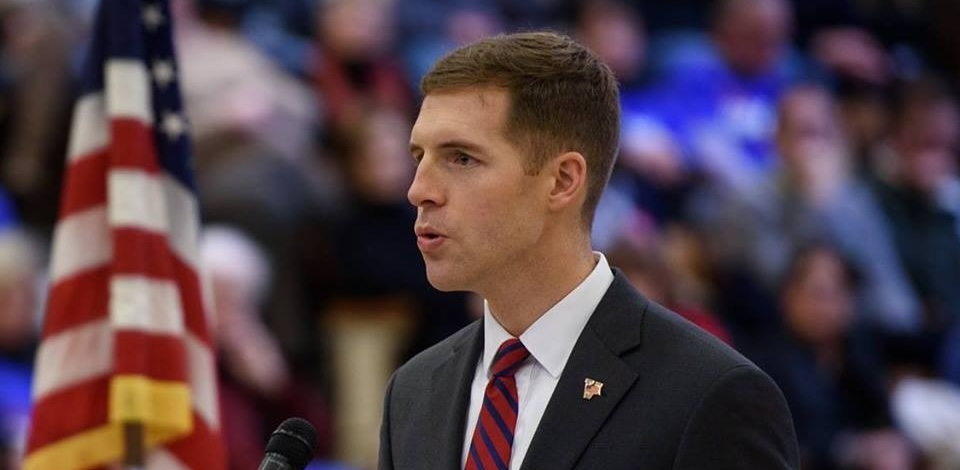

03/10/2018
During the Trump presidency, Democrats—powered by an animated base—have enjoyed notable electoral successes in states such as Virginia and Alabama. Yet that same success has not extended to special elections in the U.S. House. In these races, Democrats have largely had to fight uphill battles in GOP-leaning districts. Pennsylvania’s 18th District is just such a place: Trump won the district by a 19-point margin. This special election poses important lessons for how Democrats will fare in campaigns to regain control of the House and win statewide elections in places where Trump won in 2016.
A fixture in southwest Pennsylvania since 2005, Working America has been on the ground in PA-18 running a voter contact program combined with a large-scale listening project this election. Our goal? To understand how voters in this district feel about President Trump and Gov. Tom Wolf, and what relationship those views have to the race between Republican Rick Saccone and Democrat Conor Lamb. From Feb. 12 to Feb. 28, Working America spoke with 901 voters, a mix of our 47,000 members in the region, union members and the general public. Through our face-to-face engagement, we captured working-class voters’ perspectives and stories in their own words. We’ve also used data from the voter file and Catalist to understand trends and patterns.
Our conversations and data analysis reveal a nuanced and concerning picture for Democrats. Although Lamb has delivered a strong performance so far, the fundamentals of the race remain challenging. More importantly, our findings suggest Lamb is not winning among key pockets of voters and that Democrats will continue to struggle in southwestern Pennsylvania without a strategy to break through the electoral din. Here’s what we found:
Key Findings
Discussion
President Trump looms large over this election. Voter approval of Trump’s job performance is the strongest indicator of Saccone support.
Given that Trump won PA-18 by 19 points in 2016 and enjoys a 47-43 job approval/disapproval rating (Emerson College ePoll) in this district, it is unsurprising that Saccone has enthusiastically linked himself to the president.
Voters’ views of Trump are the driving force in this election. Of those who approve of Trump’s job performance, 63 percent are backing Saccone, compared to 8 percent for Lamb. Conversely, Lamb leads 74 percent to 4 percent among voters disapproving of Trump. Of the Trump supporters, the bulk of registered Republicans back him (70 percent), but there is also a substantial share of registered Democrats who share the pro-Trump sentiment (24 percent). These same Democrats support Saccone over Lamb (14 percent).
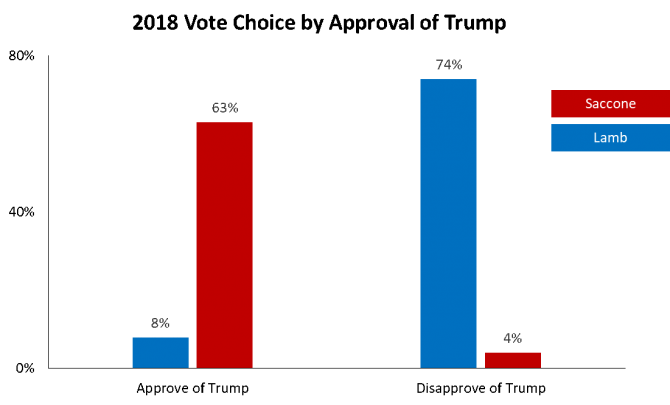

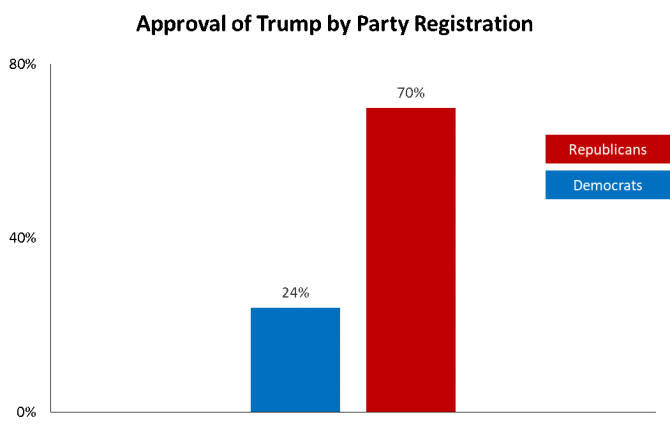

Voters regularly made connections between the president and the candidates.
Henry, a man in his 50s who works for the school board, voiced strong approval of Trump, saying he’d vote for “anybody who would help Trump,” including voting for Saccone in the upcoming election.
Yet, as we have seen in other races, many Democrats express an even stronger reaction to Trump and his allies.
Julie, 42, the mother of three special-needs children, said, “I’m worried that anybody who helps Trump will help kill my kids.” She said she would be voting for Lamb.
Trump has so thoroughly captured the attention of some conservative voters that even traditional Republican issues like cutting taxes and protecting gun ownership are overshadowed by opinions of the president in determining vote choice.
Cutting taxes has been a central plank of the Republican agenda for years. Yet, even after the massive federal tax cut for the wealthy and corporations earlier this year, only 9 percent of voters identify taxes as a top concern, and approval of Trump hovers at 56 percent among these voters. In other words, the tax cut package—the top policy accomplishment of the Trump administration—is not providing the bump in support one would anticipate.
These “tax-sensitive” voters support Saccone over Lamb 46 to 30 percent, an expectedly strong but not overwhelming margin. The implication is that Lamb—and Democrats generally—can present compelling arguments to win tax-sensitive voters, especially those who disapprove of Trump. The “tax-and-spend liberal” attacks are losing potency with these voters.
In addition to the meager advantage enjoyed by Saccone and Republicans on taxes, the support on another traditional issue for voters in Republican districts—guns and the Second Amendment—doesn’t necessarily translate to support for Saccone.
Nearly 58 percent of the voters we canvassed in the district have at least one gun in the home. Despite these high rates of gun ownership, voters do not see this issue through a partisan lens. In fact, an estimated 50 percent of Lamb voters have at least one gun in the home. The NRA has endorsed Saccone and spent thousands supporting him, yet gun issues pale in comparison to Trump approval in terms of significance in this race. Instead, voters brought up guns as a public safety concern with our canvassers, but also had other things on their minds.
Donald, age 59, a maintenance worker with a “Trespassers will be shot. Survivors will be shot twice” sign on his porch, expressed concern for his economic future and the future of his community. Having witnessed the dramatic disappearance of jobs in the region, he worried he’d have to move to stay connected with his family, since they had moved away to find better jobs. Although he began the conversation with soft support for Trump, he committed to voting for Lamb after our canvasser explained how Lamb’s infrastructure proposal would help bring jobs to the area.
Jobs and the economy remain the top issue for voters we spoke with in this district, and even gun owners and supporters prioritize a solid economic plan over a stance on guns.
Recent election losses in places like Alabama, along with Lamb’s strong polling numbers and fundraising success, have compelled the national Republicans to invest heavily in this election. They have poured $9.1 million into the district and deployed President Trump and several top Cabinet members to make appearances on behalf of Saccone. Democrats, meanwhile, are hopeful that a Lamb victory could foreshadow a blue wave in the 2018 midterms. However, Trump continues to play an outsized role in shaping the candidate choice of these voters.
Social Security and health care represent clear advantages for Lamb and Democrats more broadly.
Lamb’s clearest opening to win over voters is to focus on health care and Social Security. In an electorate whose average age is almost 60, both issues mark the breadth and depth of concerns among voters. Lamb’s explicit support for funding Social Security has been one of his strongest assets in the race. Our canvassers found that highlighting Lamb’s position on Social Security was one of the most powerful ways to persuade undecided voters to support Lamb.


*Health care voters tend to be more Democratic leaning, and tax-sensitive voters tend to be more Republican leaning. We control for partisanship to understand what the true advantage is for each party’s candidate on the issue itself.
How did working-class voters in the district discuss these issues in relation to the candidates?
Thomas, 76, is a longtime resident of Jeannette. He voted for Trump and was undecided about the special election. He was impressed with Lamb’s position on Social Security. He said, “It’s not an entitlement, it’s something we’ve earned.” Thomas said he was concerned that his children wouldn’t be able to rely on Social Security when they retire. After our canvasser’s discussion with Thomas on Social Security, he said he was leaning toward voting for Lamb.
Donna, 66, of Greensburg, was disenchanted with the political process. She relies on Social Security and said, “My Social Security went up 3 percent this year, but my Medicare cost went up 5 percent!” Donna identified as a Saccone supporter, but after our canvasser discussed Saccone’s stance on Social Security, she said she’d be voting for Lamb.
Health care frequently factored into discussions of Social Security and secure retirement.
Linda, 71, said her top issue was health care because she is “one ER visit away from losing everything.” She supports herself and her son on just $1,000 a month. Initially, Linda said she was leaning toward voting for Lamb, but by the end of her conversation with our canvasser, she said she was excited to vote for Lamb and would be sure to make it to the polls.
Over and over, our canvassers had similar conversations across PA-18. We saw a notable relationship between health care and Trump approval. Voters who said health care was their top issue were almost twice as likely to disapprove of Trump. And while some started the conversation with our canvasser leaning toward Lamb, our face-to-face conversations consistently produced greater enthusiasm and support for Lamb among voters.
Jobs and the economy remain the most important issue for voters.
As we have found in other working-class communities of all backgrounds, Republicans in this district expressed greater economic confidence in their family and community by wide margins. And while this is often a function of higher incomes among conservatives, it is telling that even in areas with crumbling factories and depressed downtown areas, Republicans continue to have a more positive outlook. It comes as no surprise that Saccone is winning with voters who cite taxes as their top issue. But the sobering reality for Democrats is that Saccone is beating Lamb among voters who are most concerned with jobs and the economy, an issue that Democrats had hoped to reclaim with their “A Better Deal” campaign.
Jeanne, 60, described herself as a conservative. Regarding Trump, she said, “He’s a jerk, but he cares about people like me, and I’ve seen more money in my paycheck after his tax plan passed.” She supported Saccone solely because he is a Republican and said she didn’t know much about him.
Among Saccone supporters who identified jobs as their top issue, our canvassers raised Lamb’s support for infrastructure investment. Canvassers also discussed Lamb’s plan to address the opioid crisis and build a healthy workforce.
Saccone doesn’t have a strong record on job creation. Instead, he is dependent on and benefits from voters tying him to Trump’s seemingly populist message about jobs and the economy. Our canvassers reported that most Saccone supporters couldn’t offer a reason for backing the candidate beyond the fact that he is a Republican. For this group of voters, Trump and his rhetoric about bringing back jobs continues to resonate and drive support for Saccone.
Voters have little knowledge of Gov. Tom Wolf or his accomplishments.
The special election in PA-18 gives us a unique opportunity to explore how voters feel about Wolf, who will be running for re-election this fall. Our findings are disquieting. There’s a widespread lack of awareness of Wolf in PA-18, with nearly 35 percent of voters having no opinion of him. By comparison, just over 10 percent of the people we spoke with had no opinion of Trump. Most worrisome, just 47 percent of voters with a high Catalist Vote Choice Index (VCI) score say they approve of Wolf. Low VCI score voters are more consolidated against Wolf, with 54 percent disapproving of him. He does not seem to be able to break through, and the partisan gridlock in Harrisburg has denied him any significant policy wins to tout.
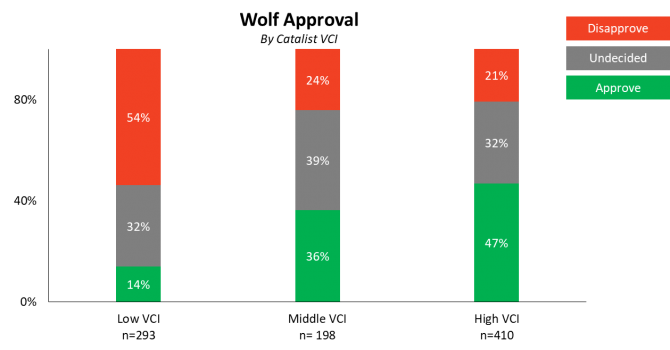

Patricia, 81, said that she had no opinion of Wolf because she “really didn’t know” what he’s done.
Will, 84, is a retired firefighter who strongly disapproves of Trump but had no opinion on Wolf. Will went so far as to call Wolf “the invisible governor.”
Our canvassers repeatedly found that people had no opinion of or lacked information about Wolf. The lack of positive reactions, particularly among likely Democratic voters, is a troubling sign. Wolf will need to raise awareness of himself and his accomplishments ahead of the November gubernatorial election.
Conclusion
Outside observers see the special election for Pennsylvania’s 18th District as a referendum on Trump. Saccone is running as an avatar of the president, and those who support Trump overwhelmingly support Saccone. Lamb’s strength as a candidate has Democrats hoping for an upset win, but the fundamentals of the race remain challenging. Over a quarter of the people we spoke with were undecided in the special election. If we exclude undecided voters, Saccone leads Lamb by over 8 points. Lamb needs to grow his lead significantly with undecided voters in order to win this election.
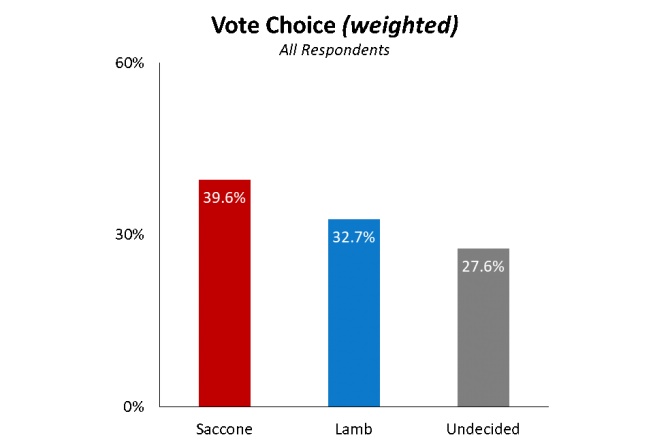

The GOP has spent millions on this race, primarily on television advertisements that link Lamb to Nancy Pelosi. Our canvassers found that these ads were effective in reducing support for Lamb. Countless voters initially indicated that they didn’t support Lamb because of his alleged ties to Pelosi. The effectiveness of these ads indicates that national Democrats have work to do to restore their image among working people.
Our canvassers were able to push back against the Pelosi advertisements by emphasizing Lamb’s positions on Social Security and health care. By engaging voters in face-to-face conversations and introducing Working America as a nonpartisan source of credible information, we were able to break through the right-wing media and attack ads and win support for Lamb. Even voters who were leaning toward Lamb were more enthusiastic about their support after our canvassers discussed the issues with them.
The fact that Lamb is losing to Saccone among voters concerned with jobs and the economy portends a bigger problem for Democrats. Across the country, we’ve seen the same trend: working people concerned about the economy are turning toward right-wing populism. Trump built his political brand on bringing back jobs, and voters remain optimistic that he’ll deliver on his promises. If Democrats want to succeed in places like Pennsylvania, Ohio and Michigan, they need to present a vision of an economy that meets the needs of working families.
METHODOLOGY
Unlike traditional public opinion polling, which is based on a random sample of people representative of a given population, we targeted working-class neighborhoods in PA-18.
From Feb. 12 to Feb. 28, Working America canvassed 901 registered voters.
In terms of demographics, the canvassed population skewed slightly female (51 percent), and the vast majority of respondents were white (98 percent). The predominant age groups were baby boomers and retirees (72 percent).
We canvassed in Allegheny, Washington and Westmoreland counties. Specifically, we spoke to voters in the boroughs of Canonsburg, Elizabeth, Export, and North Irwin, the townships of Chartiers, Robinson, South Park and Union, and the cities of Greensburg, Jeannette, Latrobe, and Washington.
To get a more precise indicator of the partisan leanings of voters, we used the Catalist Vote Choice Index [VCI] score, which assigns a value of 0-100 to each voter, with higher scores signaling Democratic support and lower scores signaling GOP support.
Even before Donald Trump had secured the Republican nomination for president, Working America detected Trump’s dramatic appeal among white, working-class voters in southwestern Pennsylvania. Our canvassers saw what many could not believe: that as early as January 2016, Trump had consolidated the Republican vote and had made inroads into the Democrats’ share of the electorate. From our conversations, we learned that while most of Trump’s support came from the staunch Republican base, one in four Democrats who had chosen a candidate showed a preference for Trump.
We use cookies and other tracking technologies on our website. Examples of uses are to enable to improve your browsing experience on our website and show you content that is relevant to you.